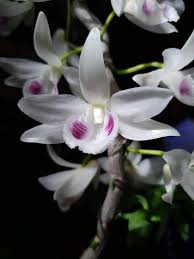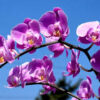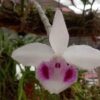# Dendrobium Orchids and Their Role in Biodiversity Conservation

Dendrobium orchids, particularly the species known as *Dendrobium nobile* or *Phong Lan Phi Điệp*, are not only celebrated for their exquisite beauty and diverse colors but also hold a crucial role in biodiversity conservation. As a prominent member of the orchid family, they symbolize the delicate balance of ecosystems and the importance of preserving natural habitats. This article delves into the various aspects of Dendrobium orchids, exploring their significance in biodiversity, the threats they face, conservation efforts, and the broader implications for ecological balance and human society.
## 1. Understanding Dendrobium Orchids
### 1.1 Botanical Overview
Dendrobium is one of the largest genera in the orchid family, Orchidaceae, with over 1,800 species distributed primarily in tropical and subtropical regions. *Dendrobium nobile* is one of the most well-known species, native to Southeast Asia. It is characterized by its distinctive pseudobulbs and racemes of flowers that can vary widely in color and size.
### 1.2 Ecological Importance
Dendrobium orchids play a vital role in their ecosystems:
– **Habitat Providers**: As epiphytes, they grow on trees without harming them, contributing to the structural complexity of forests.
– **Pollinator Attractions**: The flowers of Dendrobium orchids attract a variety of pollinators, including bees, butterflies, and hummingbirds, which are essential for the reproduction of many plant species.
– **Indicator Species**: The health of Dendrobium populations can serve as an indicator of environmental changes and the overall health of their ecosystems.
## 2. Biodiversity and Its Importance
### 2.1 Defining Biodiversity
Biodiversity refers to the variety of life on Earth, encompassing the diversity of species, ecosystems, and genetic variations within species. It is crucial for the stability and resilience of ecosystems and provides numerous benefits to humanity, including food security, medicine, and ecosystem services such as clean air and water.
### 2.2 Benefits of Biodiversity
Biodiversity offers several critical benefits, including:
– **Ecosystem Resilience**: Diverse ecosystems are more resilient to disturbances such as climate change, natural disasters, and human activities.
– **Economic Value**: Many industries, including agriculture, pharmaceuticals, and tourism, rely on biodiversity for their products and services.
– **Cultural Significance**: Biodiversity is often intertwined with cultural identities, traditions, and practices.
## 3. The Role of Dendrobium Orchids in Biodiversity Conservation
### 3.1 Contribution to Ecosystem Stability
Dendrobium orchids contribute significantly to ecosystem stability through their interactions with various organisms. Their flowers provide nectar and pollen, supporting pollinators and other wildlife. This interdependence fosters a healthy ecosystem where various species thrive together.
### 3.2 Preservation of Genetic Diversity
Dendrobium orchids represent a rich source of genetic diversity. Protecting these orchids helps conserve their unique genetic traits, which can be valuable for research, horticulture, and potential future applications in medicine and agriculture.
### 3.3 Promoting Habitat Conservation
Efforts to conserve Dendrobium orchids often lead to broader habitat conservation initiatives. Protecting the natural habitats of these orchids helps preserve the entire ecosystem, benefiting countless other species that share the same environment.
## 4. Threats to Dendrobium Orchids and Biodiversity
### 4.1 Habitat Loss
One of the primary threats to Dendrobium orchids is habitat loss due to:
– **Deforestation**: Logging and land conversion for agriculture significantly reduce available habitats.
– **Urbanization**: Expanding cities encroach on natural habitats, fragmenting ecosystems.
### 4.2 Climate Change
Climate change poses a significant threat to Dendrobium orchids through:
– **Temperature Shifts**: Changes in temperature can affect the growth and flowering patterns of orchids.
– **Extreme Weather Events**: Increased frequency of storms and droughts can damage habitats and disrupt ecological balance.
### 4.3 Over-collection
The demand for Dendrobium orchids in the ornamental plant market has led to over-collection in the wild. This unsustainable practice threatens wild populations and reduces genetic diversity.
### 4.4 Invasive Species
Invasive species can outcompete native orchids for resources, disrupting the delicate balance of ecosystems. They can introduce diseases and pests that native species are unprepared to handle.
## 5. Conservation Efforts for Dendrobium Orchids
### 5.1 Protected Areas
Establishing protected areas is one of the most effective strategies for conserving Dendrobium orchids and their habitats. These areas provide a safe haven for native species, allowing ecosystems to function naturally.
### 5.2 Sustainable Practices
Promoting sustainable agricultural and forestry practices helps minimize habitat destruction and maintain healthy ecosystems. This includes:
– **Agroforestry**: Integrating tree cultivation with agricultural practices to promote biodiversity.
– **Sustainable Harvesting**: Establishing guidelines for the collection of orchids to ensure that wild populations remain viable.
### 5.3 Community Involvement
Engaging local communities in conservation efforts is vital. Educational programs can raise awareness about the importance of Dendrobium orchids and encourage sustainable practices.
– **Orchid Conservation Societies**: Many communities have formed societies to promote the conservation of orchids through education and awareness programs.
### 5.4 Research and Monitoring
Conducting research on Dendrobium orchids and their habitats is essential for effective conservation. Monitoring populations can help identify trends and inform management strategies.
## 6. Case Studies of Successful Conservation
### 6.1 The Role of Botanical Gardens
Botanical gardens play a crucial role in conserving Dendrobium orchids by:
– **Ex Situ Conservation**: Collecting and cultivating orchids in controlled environments to protect them from threats in the wild.
– **Research**: Conducting studies on propagation techniques and genetics to improve conservation efforts.
### 6.2 Community-Led Initiatives
Several community-led initiatives have successfully protected Dendrobium orchids through:
– **Local Education Programs**: Educating community members about the ecological significance of orchids and encouraging sustainable practices.
– **Restoration Projects**: Planting native orchids in degraded areas to restore habitats and increase biodiversity.
## 7. The Broader Implications of Orchid Conservation
### 7.1 Enhancing Ecosystem Services
Conserving Dendrobium orchids contributes to the overall health of ecosystems, enhancing services such as pollination, water purification, and carbon sequestration. These services are essential for human well-being and environmental stability.
### 7.2 Promoting Sustainable Development
Orchid conservation efforts align with sustainable development goals, ensuring that natural resources are used responsibly while preserving biodiversity for future generations.
### 7.3 Fostering Cultural Heritage
Dendrobium orchids hold cultural significance in many communities, symbolizing beauty and resilience. Their conservation helps preserve cultural heritage and traditions associated with these beautiful plants.
## 8. How Individuals Can Contribute to Conservation
### 8.1 Supporting Local Conservation Efforts
Individuals can contribute by supporting local conservation organizations and initiatives that focus on Dendrobium orchids and biodiversity.
### 8.2 Practicing Sustainable Gardening
When cultivating Dendrobium orchids or other plants, individuals can adopt sustainable gardening practices:
– **Native Plants**: Incorporating native plants in gardens can support local wildlife and promote biodiversity.
– **Organic Practices**: Using organic fertilizers and pest control methods reduces the impact on the environment.
### 8.3 Raising Awareness
Spreading awareness about the importance of Dendrobium orchids and biodiversity conservation can encourage others to take action. This can be done through:
– **Social Media**: Sharing information and resources related to orchid conservation.
– **Community Events**: Participating in or organizing events focused on environmental education.
## Conclusion
Dendrobium orchids, particularly *Phong Lan Phi Điệp*, play a vital role in biodiversity conservation. Their unique ecological contributions, coupled with the threats they face, highlight the importance of concerted efforts to protect these beautiful plants and their habitats. By understanding the significance of Dendrobium orchids and actively participating in conservation initiatives, individuals and communities can contribute to a sustainable future where biodiversity thrives. The preservation of these remarkable orchids is not only essential for maintaining ecological balance but also enriches human culture and enhances the quality of life for generations to come. Together, we can ensure that the beauty and significance of Dendrobium orchids endure for years to come.

